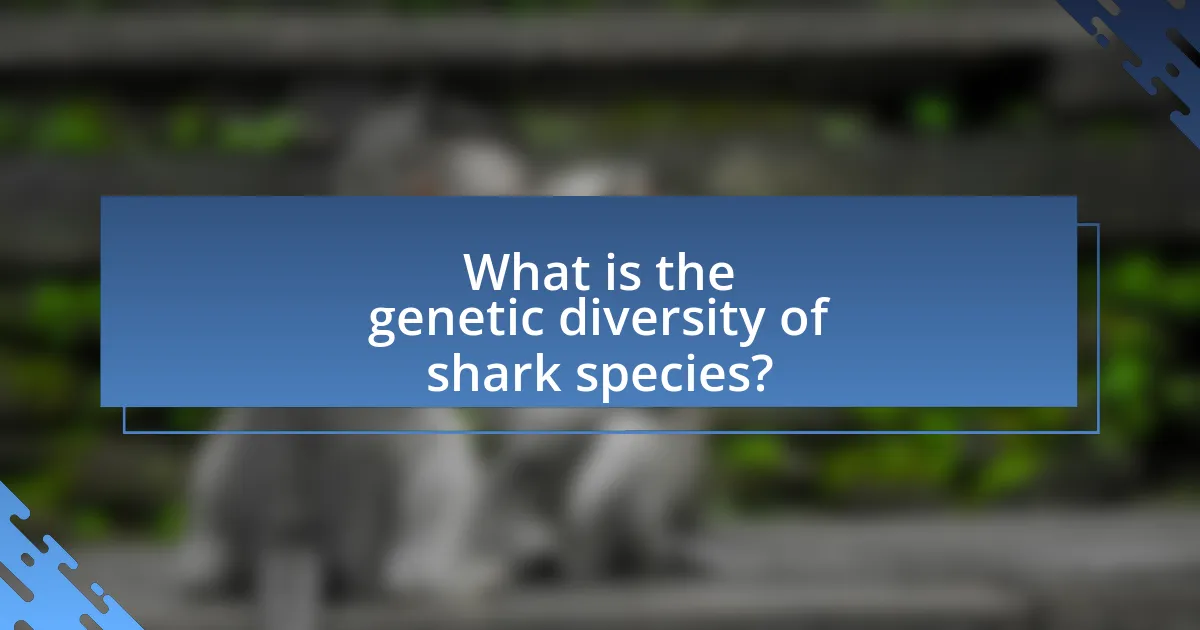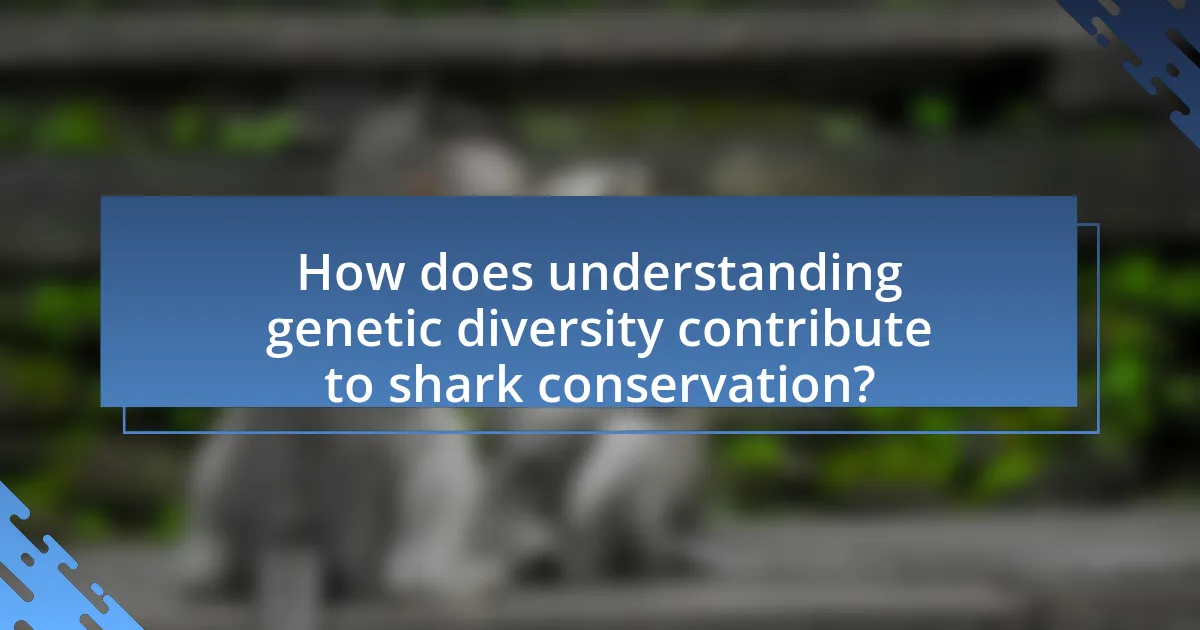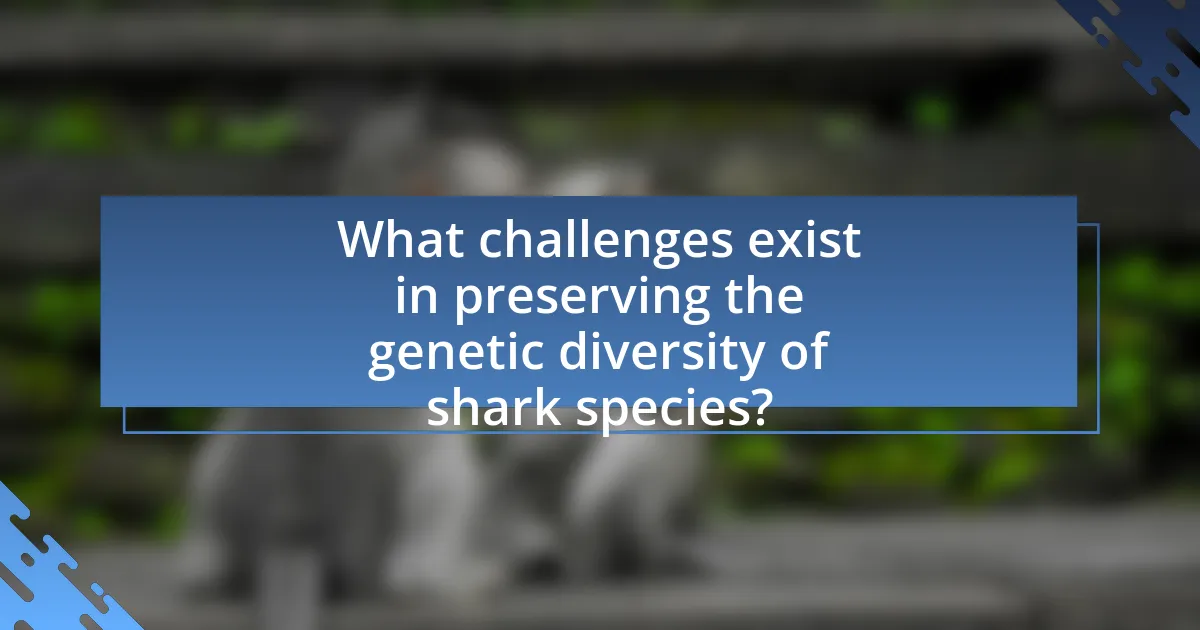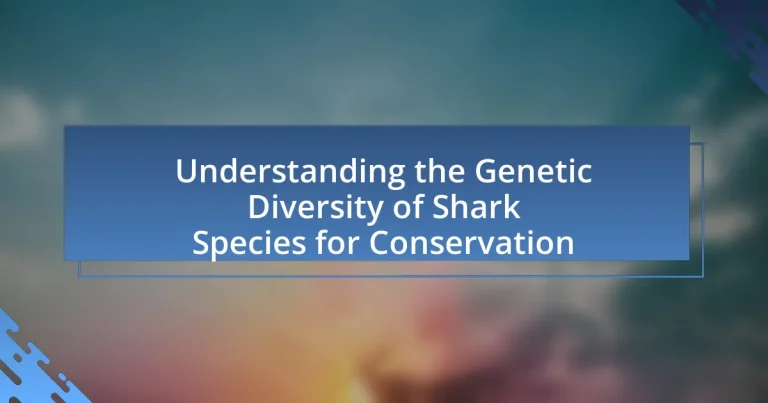The article focuses on the genetic diversity of shark species and its critical role in conservation efforts. It highlights how genetic variation enhances the adaptability and resilience of sharks to environmental changes, diseases, and human impacts. Key methods for studying genetic diversity, such as DNA sequencing and microsatellite analysis, are discussed, along with the implications of reduced genetic diversity due to overfishing and habitat loss. The article emphasizes the importance of maintaining genetic diversity for the long-term sustainability of shark populations and outlines how conservation strategies can be informed by genetic data to prioritize species protection and habitat preservation.

What is the genetic diversity of shark species?
The genetic diversity of shark species is significant, with variations observed across different species and populations. Studies have shown that genetic diversity is crucial for the adaptability and resilience of shark populations, allowing them to survive environmental changes and pressures. For instance, research published in the journal “Molecular Ecology” indicates that certain shark species, such as the great white shark, exhibit high levels of genetic diversity, which is essential for their long-term survival and evolutionary potential. This genetic variation is influenced by factors such as geographic distribution, reproductive strategies, and historical population dynamics, highlighting the importance of conserving diverse shark populations to maintain ecosystem balance and health.
Why is genetic diversity important for shark species?
Genetic diversity is crucial for shark species because it enhances their adaptability to changing environments and increases their resilience to diseases. High genetic variation allows shark populations to better cope with environmental stressors, such as climate change and habitat loss, which are significant threats to their survival. For instance, studies have shown that populations with greater genetic diversity are more likely to survive and reproduce successfully in fluctuating conditions, as they possess a wider range of traits that can be beneficial in different scenarios. This adaptability is vital for maintaining healthy ecosystems, as sharks play a key role as apex predators.
How does genetic diversity affect shark populations?
Genetic diversity significantly affects shark populations by enhancing their resilience to environmental changes and diseases. Higher genetic variation allows for a greater range of traits within a population, which can improve adaptability to shifting habitats and climate conditions. For instance, studies have shown that populations with greater genetic diversity are more likely to survive and recover from overfishing and habitat loss, as they possess a wider array of genetic traits that may confer advantages in survival and reproduction. Research published in the journal “Conservation Genetics” indicates that reduced genetic diversity in shark populations can lead to inbreeding depression, which negatively impacts reproductive success and overall population health. Thus, maintaining genetic diversity is crucial for the long-term sustainability of shark populations.
What role does genetic diversity play in shark adaptability?
Genetic diversity is crucial for shark adaptability as it enhances their ability to survive and thrive in changing environments. This diversity allows for a wider range of traits within shark populations, which can lead to increased resilience against diseases, environmental changes, and human impacts. For instance, studies have shown that populations with higher genetic variation are better equipped to cope with stressors such as climate change and habitat loss, as they possess a greater likelihood of having individuals with advantageous traits. This adaptability is vital for the long-term survival of shark species, particularly in the face of rapid ecological shifts.
What methods are used to study genetic diversity in sharks?
Methods used to study genetic diversity in sharks include molecular techniques such as DNA sequencing, microsatellite analysis, and mitochondrial DNA analysis. DNA sequencing allows researchers to examine specific genes and their variations, providing insights into genetic relationships among shark populations. Microsatellite analysis focuses on short, repetitive DNA sequences that are highly variable, making them useful for assessing genetic diversity and population structure. Mitochondrial DNA analysis, which examines the genetic material passed down maternally, helps in understanding evolutionary relationships and historical population dynamics. These methods collectively contribute to a comprehensive understanding of genetic diversity, which is crucial for effective conservation strategies.
How do researchers collect genetic samples from sharks?
Researchers collect genetic samples from sharks primarily through methods such as tissue biopsies, blood sampling, and fin clips. Tissue biopsies involve using a specialized tool to extract a small piece of skin or muscle, which provides DNA for analysis. Blood sampling is conducted by drawing blood from the shark, typically from the caudal vein, allowing for genetic material to be obtained. Fin clips involve removing a small section of a shark’s fin, which can be done with minimal harm to the animal and yields sufficient genetic material for studies. These methods are validated by their widespread use in marine biology and conservation research, ensuring that genetic diversity assessments are accurate and effective for conservation efforts.
What technologies are employed in genetic analysis of sharks?
Next-generation sequencing (NGS) technologies are employed in the genetic analysis of sharks. NGS allows for the rapid sequencing of large amounts of DNA, enabling researchers to assess genetic diversity and population structure among shark species. Techniques such as microsatellite analysis and mitochondrial DNA sequencing are also utilized to study genetic variation and evolutionary relationships. These methods provide critical insights into the conservation status of shark populations, as evidenced by studies that demonstrate the impact of genetic diversity on species resilience and adaptability.

How does understanding genetic diversity contribute to shark conservation?
Understanding genetic diversity is crucial for shark conservation as it helps identify distinct populations and their adaptive potential. By analyzing genetic variation, conservationists can determine the resilience of shark species to environmental changes and human impacts. For instance, studies have shown that genetically diverse populations are more likely to survive diseases and adapt to changing habitats, which is vital for maintaining healthy ecosystems. Furthermore, recognizing genetic diversity aids in developing targeted management strategies, ensuring that conservation efforts are effective and sustainable.
What are the implications of genetic diversity for conservation strategies?
Genetic diversity is crucial for effective conservation strategies as it enhances the resilience of species to environmental changes and diseases. High genetic diversity within shark populations allows for greater adaptability, which is essential for survival in changing ecosystems. For instance, studies have shown that populations with higher genetic variation are more likely to withstand stressors such as climate change and overfishing, leading to better long-term survival rates. Additionally, maintaining genetic diversity helps prevent inbreeding depression, which can reduce reproductive success and increase vulnerability to extinction. Therefore, conservation strategies that prioritize the preservation of genetic diversity are more likely to succeed in ensuring the sustainability of shark species and their ecosystems.
How can genetic information guide habitat protection efforts?
Genetic information can guide habitat protection efforts by identifying genetic diversity and population structure within shark species, which is crucial for effective conservation strategies. For instance, understanding the genetic makeup of different shark populations allows conservationists to prioritize habitats that support genetically distinct groups, ensuring the preservation of unique genetic traits essential for species resilience. Research has shown that areas with high genetic diversity are often more resilient to environmental changes, making them critical for protection. A study published in “Molecular Ecology” by Heupel et al. (2010) demonstrated that genetic data can reveal important insights into the migratory patterns and breeding sites of sharks, enabling targeted habitat protection measures that align with their life cycles.
What role does genetic diversity play in breeding programs?
Genetic diversity is crucial in breeding programs as it enhances the adaptability and resilience of species. In the context of shark conservation, maintaining a broad genetic base allows for better responses to environmental changes and diseases, which is vital for the survival of populations. Research indicates that higher genetic diversity can lead to increased fitness and reproductive success, as seen in various species where inbreeding depression negatively impacted population viability. For instance, studies on marine species have shown that genetic diversity correlates with improved survival rates in changing habitats, underscoring its importance in effective breeding strategies.
Why is it crucial to monitor genetic diversity in endangered shark species?
Monitoring genetic diversity in endangered shark species is crucial for their conservation because it helps assess their ability to adapt to environmental changes and resist diseases. Genetic diversity is essential for the survival of species, as it enhances resilience and reproductive success. For instance, studies have shown that populations with higher genetic variation are more likely to survive and thrive in changing ecosystems. Additionally, understanding genetic diversity can inform management strategies, such as identifying distinct populations that may require targeted conservation efforts. This approach is supported by research indicating that loss of genetic diversity can lead to inbreeding and decreased fitness, ultimately threatening the survival of endangered species.
What are the consequences of reduced genetic diversity in sharks?
Reduced genetic diversity in sharks leads to increased vulnerability to diseases, reduced adaptability to environmental changes, and a higher risk of extinction. This diminished genetic variation limits the ability of shark populations to respond to stressors such as climate change, habitat loss, and overfishing. For instance, studies have shown that populations with low genetic diversity are less resilient to disease outbreaks, which can decimate numbers and disrupt ecosystems. Additionally, a lack of genetic diversity can hinder reproductive success, as inbreeding may result in lower fertility rates and increased susceptibility to genetic disorders. These factors collectively threaten the survival of shark species, emphasizing the importance of genetic diversity for their conservation.
How can conservationists use genetic data to prioritize species for protection?
Conservationists can use genetic data to prioritize species for protection by assessing genetic diversity and population structure, which helps identify species at risk of extinction. For instance, genetic analyses can reveal low genetic diversity in a shark species, indicating a reduced ability to adapt to environmental changes and increased vulnerability to disease. Studies have shown that species with higher genetic diversity, such as the great white shark, are more resilient, while those with lower diversity, like the hammerhead shark, may require immediate conservation efforts. By focusing on species with limited genetic variation, conservationists can allocate resources effectively to protect those most at risk, ensuring the preservation of biodiversity within marine ecosystems.

What challenges exist in preserving the genetic diversity of shark species?
Preserving the genetic diversity of shark species faces significant challenges, primarily due to overfishing, habitat loss, and climate change. Overfishing has led to population declines, reducing the effective population size and genetic variability among sharks. For instance, studies indicate that certain shark populations have experienced a genetic bottleneck, which diminishes their ability to adapt to environmental changes. Habitat loss, particularly from coastal development and pollution, further exacerbates the situation by disrupting breeding grounds and migratory routes essential for maintaining genetic diversity. Additionally, climate change affects ocean temperatures and acidification, which can alter shark distribution and reproductive success, thereby impacting genetic diversity. These factors collectively hinder conservation efforts aimed at maintaining the genetic health of shark populations.
What threats do shark populations face that impact genetic diversity?
Shark populations face several threats that significantly impact their genetic diversity, primarily due to overfishing, habitat loss, and climate change. Overfishing leads to population declines, which reduces the effective population size and can result in inbreeding, thereby diminishing genetic variability. Habitat loss, such as the destruction of coastal ecosystems like mangroves and coral reefs, further isolates shark populations, limiting gene flow between groups. Climate change affects ocean temperatures and acidification, altering shark distribution and reproductive patterns, which can disrupt genetic mixing. These factors collectively threaten the resilience of shark populations, making them more vulnerable to extinction and reducing their ability to adapt to environmental changes.
How does overfishing affect the genetic diversity of sharks?
Overfishing significantly reduces the genetic diversity of sharks by depleting populations and limiting their reproductive potential. When shark populations are overfished, the remaining individuals often belong to a smaller gene pool, which can lead to inbreeding and a decrease in genetic variation. This reduction in genetic diversity makes sharks more vulnerable to diseases, environmental changes, and reduces their adaptability to changing ecosystems. Studies have shown that species with lower genetic diversity are at a higher risk of extinction, as evidenced by the decline of various shark species due to unsustainable fishing practices.
What impact does habitat loss have on shark genetic diversity?
Habitat loss significantly reduces shark genetic diversity by isolating populations and limiting gene flow. When sharks lose their natural habitats due to human activities such as coastal development, pollution, and overfishing, their populations become fragmented. This fragmentation leads to inbreeding, which decreases genetic variation and increases vulnerability to diseases and environmental changes. Studies have shown that reduced genetic diversity can impair the ability of shark populations to adapt to changing conditions, ultimately threatening their survival. For instance, research published in “Conservation Genetics” highlights that habitat degradation directly correlates with decreased genetic diversity in several shark species, emphasizing the critical need for habitat protection to maintain their genetic health.
How can policy and legislation support shark genetic diversity conservation?
Policy and legislation can support shark genetic diversity conservation by establishing protective measures that regulate fishing practices and habitat preservation. Effective policies can include restrictions on shark fishing, the creation of marine protected areas, and regulations that limit bycatch, which collectively help maintain healthy populations and genetic diversity. For instance, the Convention on International Trade in Endangered Species of Wild Fauna and Flora (CITES) regulates international trade of endangered shark species, thereby reducing pressure on their populations. Additionally, legislation that mandates research and monitoring of shark populations can provide critical data to inform conservation strategies, ensuring that genetic diversity is preserved for future resilience against environmental changes.
What international agreements exist to protect shark species?
Several international agreements exist to protect shark species, including the Convention on International Trade in Endangered Species of Wild Fauna and Flora (CITES), which regulates trade in endangered species, and the Convention on Migratory Species (CMS), which aims to conserve migratory species, including sharks. Additionally, the Food and Agriculture Organization (FAO) has established the International Plan of Action for the Conservation and Management of Sharks (IPOA-Sharks), which encourages countries to develop national plans for shark conservation. These agreements collectively aim to mitigate threats to shark populations and promote sustainable management practices.
How can local regulations enhance genetic diversity preservation?
Local regulations can enhance genetic diversity preservation by establishing protected areas and implementing sustainable fishing practices. These regulations create safe habitats for shark species, allowing populations to thrive and interbreed, which is essential for maintaining genetic diversity. For instance, the establishment of marine protected areas (MPAs) has been shown to increase the abundance and diversity of marine species, including sharks, by reducing human impact and promoting recovery of overfished populations. Research indicates that MPAs can lead to a 20-50% increase in species richness, thereby supporting the genetic variability necessary for resilience against environmental changes.
What practical steps can individuals take to support shark conservation?
Individuals can support shark conservation by reducing their consumption of shark products, advocating for sustainable fishing practices, and participating in local conservation efforts. By choosing not to buy shark fin soup or other shark-derived products, individuals can decrease demand, which is a significant factor in shark population decline. Advocating for sustainable fishing practices, such as supporting regulations that protect shark habitats and promote catch-and-release fishing, helps ensure healthier shark populations. Additionally, participating in local conservation initiatives, such as beach clean-ups or educational programs, raises awareness and contributes to the protection of marine ecosystems where sharks thrive. These actions collectively contribute to the preservation of shark species and their genetic diversity, which is crucial for their survival.


